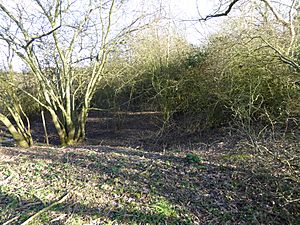Hamstead Marshall Pit facts for kids
| Site of Special Scientific Interest | |
 |
|
| Area of Search | Berkshire |
|---|---|
| Interest | Geological |
| Area | 0.2 hectares (0.49 acres) |
| Notification | 1985 |
| Location map | Magic Map |
Hamstead Marshall Pit is a very special place in Berkshire, England. It's a small area, about the size of half a football field (0.2-hectare (0.49-acre)). This site is important because it helps us understand Earth's history.
It's known as a Site of Special Scientific Interest (SSSI) because of its unique geology. This means the rocks and landforms here are very important for science. It's also a Geological Conservation Review site, which means it's one of the best examples of its kind in the whole country.
Contents
A Window into the Past
Hamstead Marshall Pit was once a gravel pit. This is a place where people dug up gravel, which is a mix of small stones and sand. When they dug, they uncovered something amazing: layers of gravel that tell a story about ancient times.
How Gravel Pits Help Us Learn
Imagine digging a hole and finding clues about what happened thousands of years ago! That's what a gravel pit can do. The layers of gravel at Hamstead Marshall Pit are like pages in a history book. They show us how the land changed over a very long time.
The Story of the River Kennet
The gravels found here were left behind by the River Kennet. This river still flows nearby today. But about 450,000 years ago, the river looked very different. It was a time when huge sheets of ice covered much of the Earth.
The Anglian Ice Age
The gravels were deposited during a period called the Anglian ice age. This was one of the coldest times in Earth's history. Glaciers, which are giant rivers of ice, moved across the land. As they melted, they released huge amounts of water and sediment, including the gravels we see at Hamstead Marshall Pit. Studying these gravels helps scientists understand how ice ages shaped our landscape.
Early Humans and Their Tools
Even more exciting, scientists found flint hand axes at the site. These tools are very old, possibly even older than the gravels themselves! They show that early humans lived and hunted in this area a very long time ago.
Life in the Middle Palaeolithic
The hand axes suggest that people were active here during the Middle Paleolithic period. This was a time when early humans, like Neanderthals, used stone tools for hunting and daily life. Finding these tools helps us learn about where and how our ancient ancestors lived. It's like finding a treasure map to human history!

